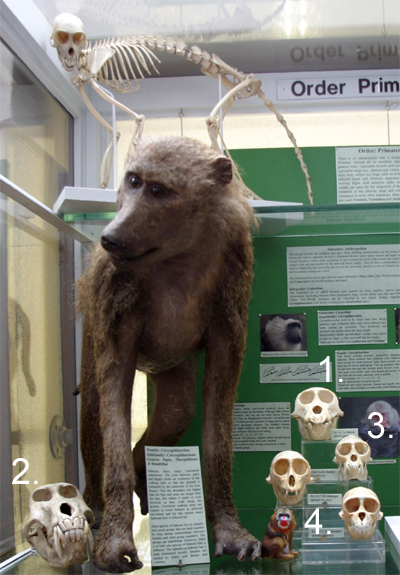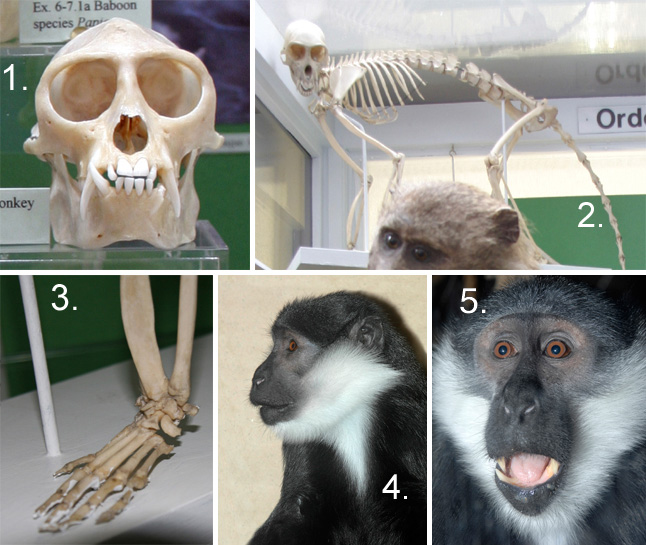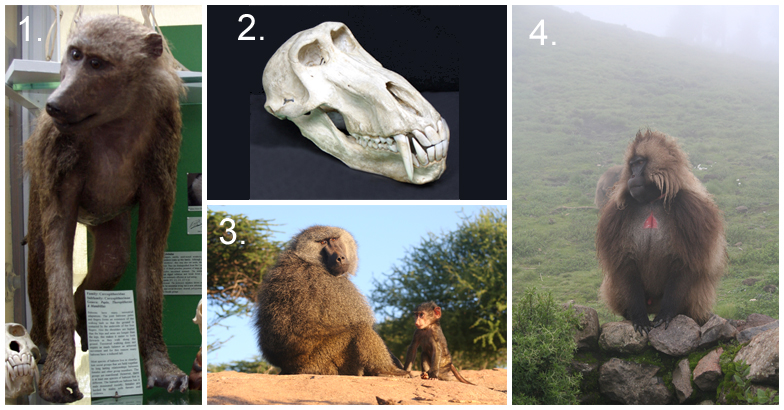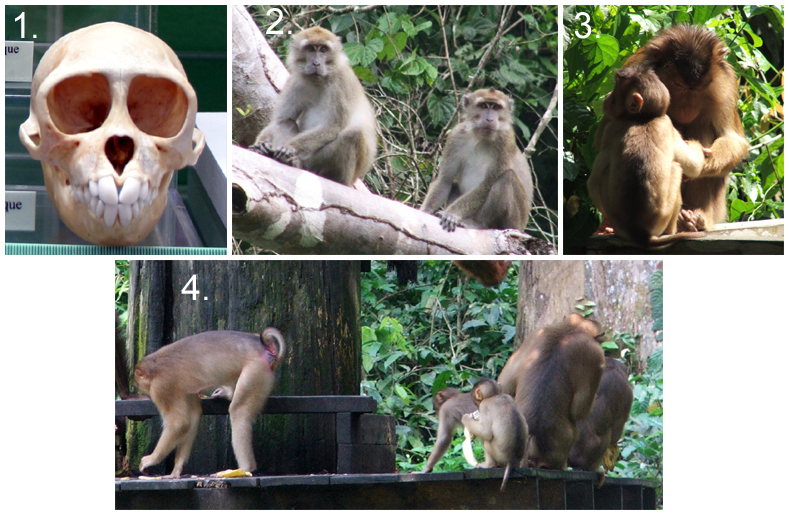
FAMILY CERCOPITHECIDAE
SUBFAMILY CERCOPITHICINAE
CHEEK POUCH OR TYPICAL MONKEYS
The subfamily Cercopithecinae contains 45 species of ‘typical’ monkeys such as the guenons, baboons and macaques, distinguished by the possession of cheek pouches. Cercopithecines are primarily fruit eaters but different species may eat seeds, fruit, flowers, buds, leaves, gum, roots, bulbs, insects, crabs, fish, and lizards – depending on what is available. Baboons also hunt the young of large mammals like gazelle.
The characteristic cercopithecine cheek pouches extend down both sides of the neck and are used for storing food. The pouches are very useful if the monkeys are disturbed by predators while looking for food on the ground. With their food in their pouches and hands free, they can escape quickly on all four limbs to the safety of trees and rocks. Cercopithecines, unlike colobines, have thumbs and can use their hands to fill and empty their pouches and to peel fruit.
Cercopithecines have very varied behaviour and social structures. They are mostly diurnal but some are nocturnal. Some species are arboreal, others are terrestrial. Groups are usually polygynous, i.e. many females occurring in a group with one male, but may live in mixed groups of many males and many females. The males are usually larger and their enlarged canine teeth are used for intimidation and fighting.

1. Baboons feeding on the ground.
2. Adult baboons carry the babies on their backs

SKULLS AND DENTITION
Most cercopithecines have relatively long faces, especially baboons, and large jaws. Their jaws have powerful muscles giving the back teeth a strong nutcracker action; the length of the jaw increases the grinding surface of the premolar and molar teeth. Cercopithecines have the typical dental formula of an Old World Monkey: I2/2; C1/1; P2/2; M3/3 = 32. The skull of the young baboon (1) has a shorter snout than the skull of the adult baboon (2), but the overall shape of its skull and jaw and the position of its orbits is still very different from the same features in the skulls of the guenons (3) and macaques (4).
CERCOPITHECINE LINEAGES AND DISTRIBUTION
Cercopithecines are thought to be a modern group that emerged relatively recently in Africa and radiated into two main lineages. One lineage includes the arboreal, forest dwelling guenons, found only in sub-Saharan Africa. The other lineage comprises the terrestrial baboons, mandrill, drill and gelada, and the arboreal mangabeys, also found only in sub-Saharan Africa, and the macaques. Only one species of macaque occurs in Africa and only north of the Sahara in countries bordering the Mediterranean sea, but many other species occur throughout Asia - from India and S.E. Asia as far east as Japan and as far north as China and Tibet.
GUENONS
The guenons are a large group of forest dwelling monkeys belonging to the genus Cercopithecus spp. Most species are arboreal but some species are adapted to live in dense forest undergrowth, others in dense canopy forest and yet others in relatively open tree canopies. The closely related vervet monkey, Chlorocebus aethiops, is semi-terrestrial living on the ground and in trees, often near water courses.

1. Skull of Cercopithecus sp. The skull has a short snout with nasal opening and the rounded brain case of a typical monkey. The front of the face is dominated by the two large forward facing orbits for the eyes.
2. Skeleton of Cercopithecus sp. The skeleton shows typical features of a monkey that progresses on all four feet and can obtain and process food with its hands and opposable thumb. It has a small head, a long back with a short narrow cage, long legs of equal length with all five digits on all four feet, a long balancing tail. The clavicle – collar bone – in the pectoral girdle is well developed and confers a high degree of lateral movement on the shoulder joint. The ulna and radius in the lower forearm and the tibia and fibula in the lower hind limb are separate. We do not know what species this is, but its skeletal form would enable its owner to climb and leap and walk on all fours in trees and on the ground and, if necessary, run quickly on the ground for short distances to evade predators.
3. Detail of fore feet of skeleton of Cercopithecus sp. shows the five digits and separate ulna and radius.
4 and 5. L'hoest monkey (Cercopithecus l'hoesti) Photograph courtesy of Alan R. Thomson, copyright The Royal Zoological Society of Scotland.
BABOONS
The classification and naming of the monkeys commonly called baboons is controversial. Some systems treat the five major populations as five species. Others classify all baboons as a single species divided into five subspecies or races. Irrespective of their names, the five kinds have radiated into various ecological niches wherever they can find water - in grasslands, highlands, bush and forest edges. Most baboons live in closely-knit social groups held together by long-lasting relations between females and other members of the groups. Baboons only occur in sub-Saharan Africa – probably because they cannot tolerate extremes of temperature and have been unable to move across the more arid Northern regions of Africa into Asia .
The ‘earliest’ baboons included a number of species of grass-eating geladas that once flourished across Africa. Today, geladas are confined to relict populations of one species, Theropithecus gelada, in the highlands of Ethiopia. The gelada is a specialist feeder – it extracts seeds from the grasses it plucks from the sward with its opposable thumb and forefingers while sitting on the ground or shuffling along on its bottom.

1. Stuffed specimen of a baboon, Papio sp. Baboons exhibit a number of structural and locomotory adaptations to a terrestrial existence. They have the typically shortened back of a ground-walking monkey. Their shoulders are higher than their hips and their arms are longer than their legs, which makes it easier to look forward when walking along the ground. When baboons walk, they lengthen the forelimb by holding the palm down vertically and rest on the undersides of their fingers. Many species of baboons have short tails, as they do not need a tail to help them balance when walking on the ground. Their powerful spoon-shaped hands are used to grasp food and dig up bulbs and roots.
2. Skull of an adult male baboon, Papio sp. This baboon skull shows the forward facing orbits of a haplorhine monkey combined with the very long baboon snout. The jaw is powerful and equipped with large molar teeth used for grinding up the hard siliceous leaves of the grasses which baboons eat in large amounts. As seen here, male baboons have extremely large intimidating canine teeth which are sharpened by honing on the first lower premolar.
3. An adult male Olive Baboon, Papio anubis, with an infant female. Photograph courtesy of R. Hoolihan (Uaso Ngiro Baboon Project).
4. Theropithecus gelada, adult male showing the red patches on the chest, which gave the species the English name of ‘bleeding-heart monkey’. Photograph courtesy of R. Hoolihan (Uaso Ngiro Baboon Project).
MACAQUES
The heavily built macaques can live off the most arid land and survive extremes of temperature. The Barbary macaque (Macaca sylvanus) occurs naturally in Africa north of the Sahara and is maintained in Gibraltar at the very tip of Europe by the human inhabitants of this large rock. The other fourteen species live in a variety of habitats, some in very harsh conditions, throughout Asia. Some species are both arboreal and terrestrial, others are semi-terrestrial. Each species is adapted to survive the local conditions in which it lives and to feed on the particular kinds of food it finds there. The species living in cold climates have thick shaggy fur; those living in warm climates have lighter coats. Some have short tails, some have long tails and others lack tails. Macaques live in groups that may include several males and a number of females; the females usually remain in the same groups throughout their lives.

1. Skull of Macaca sp, macaques. Macaque skulls have a short snout with nasal opening and the rounded brain case of a typical monkey. The front of the face is dominated by the two large forward facing orbits for the eyes.
In Borneo, small, lontailed, crab-eating macaques, Macaca fasicularis (2) live in the same forests as large, short-tailed, pig-tailed macaques, M. nemestrina (3 & 4). Photographs courtesy of J. Glendinning.






